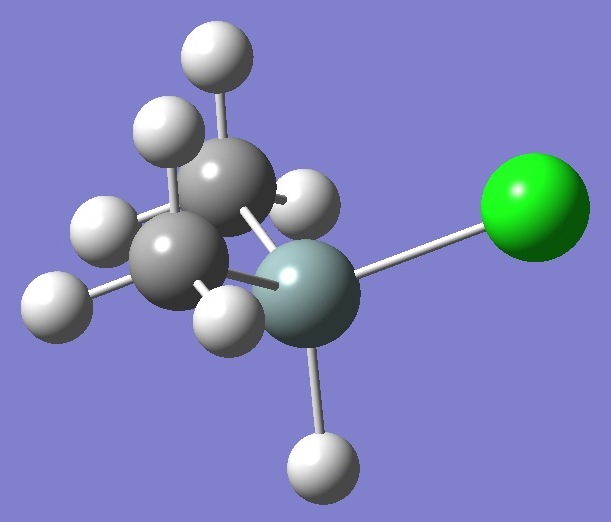|
|
|
|
|
|
|
|
|
|
|
|
|
|
|
|
|
|
|
|
|
CH3SiHClCH3 |
|

|
|
|
|
|
|
|
|
|
|
|
|
|
|
|
|
|
|
|
|
|
|
|
|
|
|
|
|
|
|
|
|
|
|
|
|
|
|
|
|
|
|
Chlorine |
|
|
|
Nuclear
Quadrupole Coupling Constants |
|
|
|
in Chlorodimethylsilane |
|
|
|
|
|
|
|
|
|
|
|
|
|
|
|
|
|
|
|
|
|
|
|
|
|
|
|
|
|
|
|
|
|
Calculation of the chlorine nqcc's in
chlorodimethylsilane was made on the heavy atom substitution structure
of Kawashima [1] (with the hydrogen geometry calculated here by
MP2/6-31G(d,p) optimization). These are compared with the
experimental nqcc's [1] in Table 1. Structure parameters are
given in Table 2. |
|
|
|
|
|
|
|
|
|
|
|
|
In Table 1, RMS is the root mean square difference
between calculated and experimental diagonal nqcc's (percentage of the
average of the magnitudes of the experimental nqcc's). RSD is the
calibration residual standard deviation for the B1LYP/TZV(3df,2p) model
for calculation of the chlorine nqcc's. |
|
|
Subscripts a,b,c refer to the
principal axes of the inertia tensor; x,y,z to the principal axes
of the nqcc tensor. The nqcc y-axis is chosen coincident with the
inertia b-axis, these are perpendicular to the molecular symmetry plane.
Ø (degrees) is the angle between its subscripted
parameters. ETA = (Xxx - Xyy)/Xzz. |
|
|
|
|
|
|
|
|
|
|
|
|
|
|
|
|
|
|
|
|
|
|
| |
|
|
|
|
|
|
|
|
Table 1. Chlorine nqcc's
in CH3SiHClCH3 (MHz). |
|
| |
|
|
|
|
|
|
|
|
|
|
|
Calc. |
|
Expt. [1] |
|
| |
|
|
|
|
|
|
|
|
35Cl |
Xaa |
- |
33.00 |
- |
32.4561(50) |
|
|
|
Xbb |
|
18.42 |
|
18.061(8) |
|
|
|
Xcc |
|
14.58 |
|
14.395(8) |
|
|
|
|Xac| |
|
13.39 |
|
|
|
|
|
|
|
|
|
|
|
|
|
RMS |
|
0.39 (1.8 %) |
|
|
|
|
|
RSD |
|
0.49 (1.1 %) |
|
|
|
|
|
|
|
|
|
|
|
|
|
Xxx |
|
18.09 |
|
|
|
|
|
Xyy |
|
18.42 |
|
|
|
|
|
Xzz |
- |
36.51 |
|
|
|
|
|
ETA |
|
0.009 |
|
|
|
|
|
Øz,a |
|
14.69 |
|
|
|
|
|
Øa,SiCl |
|
14.02 |
|
|
|
|
|
Øz,SiCl |
|
0.67 |
|
|
|
|
|
|
|
|
|
|
|
|
37Cl |
Xaa |
- |
26.05 |
- |
25.619(7) |
|
|
|
Xbb |
|
14.52 |
|
14.226(19) |
|
|
|
Xcc |
|
11.54 |
|
11.393(19) |
|
|
|
|Xac| |
|
10.47 |
|
|
|
|
|
|
|
|
|
|
|
|
|
RMS |
|
0.31 (1.8 %) |
|
|
|
|
|
RSD |
|
0.44 (1.1 %) |
|
|
|
|
|
|
|
|
|
|
|
|
|
|
|
|
|
|
|
|
|
|
|
|
| |
|
|
| Table 2. Heavy atom molecular structure parameters, rs
[1] (Å and degrees). The complete structure is given here in Z-matrix format. |
|
|
|
|
SiCl |
2.0604(10) |
|
SiC |
1.8542(10) |
|
ClSiC |
108.43(20) |
|
CSiC |
112.32(15) |
|
|
|
|
|
|
|
|
|
|
|
|
|
|
|
|
|
|
|
|
|
|
|
[1] Y.Kawashima, J.Mol.Struct. 563-564,227(2001). |
|
|
|
|
|
|
|
|
|
|
|
|
|
|
|
|
|
|
|
|
|
|
SiH3Cl |
SiHCl3 |
SiCl2 |
|
|
|
CH3SiCl2CH3 |
(CH3)3SiCl |
SiCl |
|
|
|
|
|
|
|
|
|
|
|
|
|
|
|
|
|
|
|
|
|
|
|
|
|
|
|
|
|
Table of Contents |
|
|
|
|
|
Molecules/Chlorine |
|
|
|
|
|
|
|
|
|
|
|
|
|
|
|
|
|
|
|
|
|
|
|
|
|
|
|
|
|
|
CH32SiHCl.html |
|
|
|
|
|
|
Last
Modified 14 March 2006 |
|
|
|
|
|
|
|
|
|
|
